
Guanyin, China, 19th century, Glaze on porcelain, Gift of Toshie and Frank Mosher, Scripps College, Claremont, California
For over two millennia, Buddhist practitioners have aspired to liberate themselves and all other living beings from the suffering of saṃsāra—a Sanskrit term which refers to the never-ending cycle of death and rebirth endured by all inhabitants of the six Buddhist realms of existence. In order to transcend saṃsāra, Buddhists strive to rid themselves of the source of suffering—the “three poisons” of attachment, aversion, and ignorance—and thereby attain a state of spiritual awakening or “enlightenment” known as nirvāṇa.
The path to nirvāṇa is long, taxing, and littered with obstacles. However, in the Mahāyāna Buddhist traditions of East Asia and the Vajrayāna traditions of the Himalayas, practitioners may call upon the guidance of deities to assist them. Although the majority of these deities are male, the Mahāyāna and Vajrayāna Buddhist pantheons also feature a number of formidable female deities. This exhibition highlights paintings and sculptures of female Buddhist deities from the Scripps College art collection that illustrate the complexity and indispensability of the divine feminine in Buddhism. The deities featured here assume an array of forms personifying divine wisdom, great compassion, and terrifying wrath, all to assist practitioners on their spiritual journeys to nirvāṇa.
This exhibition was curated by Anabella Walser (SC ’22), the Peggy Phelps Curatorial Intern for the Summer of 2020. Special thanks go to Dr. Zhiru Ng at Pomona College, professor of religious studies and coordinator of Asian studies, and Meher McArthur, the Gabrielle Jungels-Winkler curator of academic programs and collections at Scripps College, for their guidance. The exhibition is dedicated to the memory of Peggy Phelps, a former Claremont Graduate University trustee, compassionate philanthropist, and generous patron of the arts.
-Anabella Walser ’22, Peggy Phelps Curatorial Intern
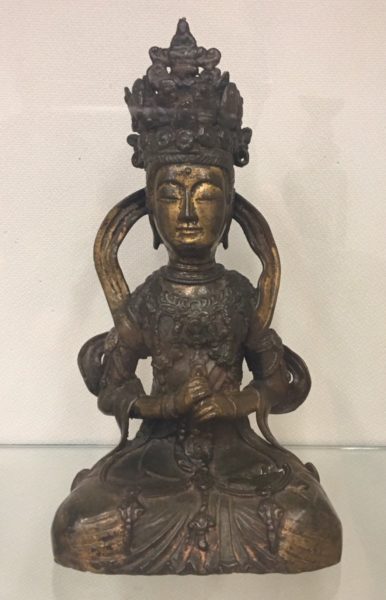
Seated Guanyin Bodhisattva
China, 19th century
Gilt bronze
5 ½ in. x 4 in. x 10 ¼ in.
Gift of the Dr. Ralph Riffenburgh and Angelyn Riffenburgh Collection of Japanese Art
Scripps College, Claremont, California
2018.8.1
One of the most important, beloved, and complex deities in Buddhism is the infinitely compassionate Avalokiteśvara (Chinese: Guanyin), whose name translates to “The Lord who looks down [compassionately at the suffering beings].” Avalokiteśvara is regarded in all Mahāyāna and Vajrayāna traditions to be a “bodhisattva,” an enlightened being who has taken a vow to work tirelessly over countless lifetimes to guide other living beings to nirvāṇa. To indicate their distinguished status, bodhisattvas are portrayed adorned with lavish jewelry, crowns, and elegant robes. Avalokiteśvara is recognizable by the seated Amitāhba Buddha image in his crown—a nod to his affiliation with Amitāhba, the celestial Buddha of the Western Pure Land.
Avalokiteśvara was originally regarded as a male bodhisattva. In Ancient India, however, bodhisattvas were represented as princes, who were typically imagined as effeminate (i.e. slender, refined, and lacking muscle) due to their luxurious and relaxed lifestyles. It follows, then, that the gender identity of representations of Avalokiteśvara often appears to be ambiguous, as is the case in this 19th century sculpture. His apparent gender fluidity is reaffirmed by Chapter Twenty-Five of the Lotus Sūtra, a scripture which explains that Avalokiteśvara can adopt up to thirty-three different guises—including those of a nun, a wife, and a girl—in order to assist living beings in their spiritual cultivation.

Guanyin
China, 19th century
Glaze on porcelain
Gift of Toshie and Frank Mosher
Scripps College, Claremont, California
2007.11.4
The bodhisattva Guanyin—the Chinese Buddhist name for Avalokiteśvara—is worshipped all over mainland China, Hong Kong, Macao, and among the Chinese diaspora worldwide. Guanyin was introduced to China in the first centuries CE, having traveled with the Buddhist religion to China via trade routes from India. As early as the 12th century, Guanyin was well-established in China as a feminine deity. By the Yuan dynasty (1206-1368), her characterization as a female was cemented in the Chinese cultural consciousness.
Today, Guanyin is revered as a compassionate savior, mother figure, and bestower of children. She is primarily worshipped by Chinese Buddhist women who request her assistance during pregnancy, while giving birth, and when attempting to conceive a child. She is also considered to be the principal female protector of pregnant women, fetuses, and young children.
Flanking this figure of Guanyin are her two acolytes—on her right, the young girl Long Nü (Dragon Girl), and on her left, the young boy Shan Cai (“Good Youth”)—to whom Guanyin taught the Buddha’s teachings after they happened upon her meditating on Mount Putuo, her island paradise. In her left hand, she holds a water vessel filled with the divine nectar of compassion, which is believed to possess special healing properties. Although this figure does not carry an object in her right hand, representations of Guanyin that hold a water vessel also tend to clutch a small willow branch, which she uses to gently sprinkle the divine nectar onto those in need of its powers.
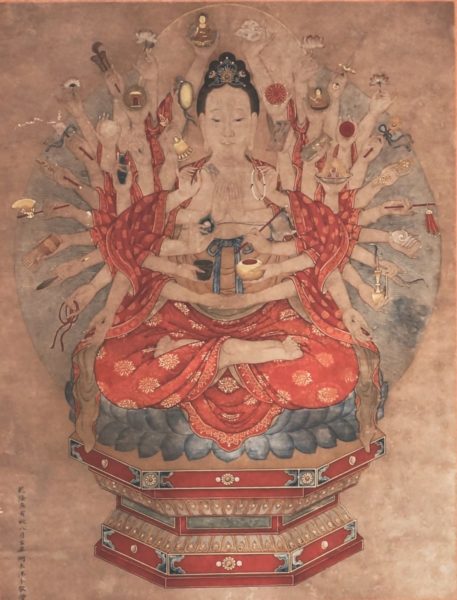
Zhou Ben
Thousand-Armed Guanyin
China, 1770
Ink and pigment on paper
28 7/16 in. x 21 3/4 in.
Scripps College, Claremont, California
0253
This multi-armed Chinese deity is a representation of the Thousand-Armed, Thousand-Eyed Guanyin, an emanation of Avalokiteśvara common in both the Mahāyāna and Vajrayāna Buddhist traditions. In Chinese, Guanyin means “One who perceives the sounds [of the suffering world],” signifying her constant attunement to the suffering of all living beings in the six realms of saṃsāra. Her form as the Thousand-Armed, Thousand-Eyed Guanyin exemplifies her altruistic ever-responsiveness to this suffering—out of her great compassion and mercy for all living beings, she extends her one thousand arms in every direction to offer them an escape from their misery. In some images, an eye inhabits the center of each palm—an assertion of her constant witness to the suffering of the universe. Here, only three of her palms feature eyes.
This Thousand-Armed, Thousand-Eyed Guanyin wears red robes and sits in lotus position atop a lotus pedestal. A faded blue lunar halo surrounds her. Typically, this deity has between thirty and fifty visible arms and hands, with the other 950+ being represented symbolically. This particular representation possesses forty-four distinct arms and hands. Two of these hands rest in her lap in meditation, while another pair is clasped together at her breast in the anjali mudrā, the gesture of prayer and respect. Her two bottom-most hands and one hand on her right side have an eye in the center of each palm. In each of her thirty-seven other hands, she clutches a different ritual instrument meant to assist practitioners in their spiritual cultivation. These thirty-seven objects are as follows: a red lasso, an arrow, rice sheaths, an axe, a human skull, a fan, a fish basket, a wish-granting jewel, a willow branch, a bell, a mirror, a vase, a moon disc, a palace, a ritual water vessel (kundika), a bow, a conch shell, a fly whisk, a vajra scepter, a sword, a cloud, an alms bowl, a flag, prayer beads (mālā), three jewels in a dish, a sūtra, a sūtra box, a sun disc, a dharma wheel, two staffs, two seated Buddha figurines, and four lotuses.
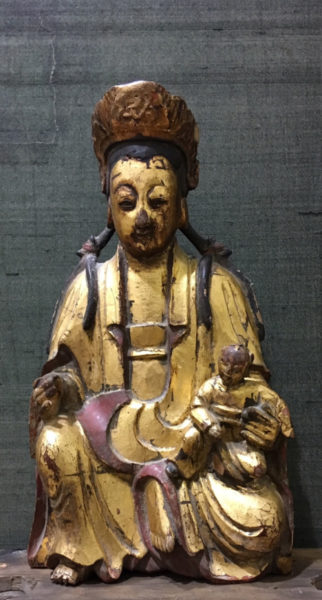
Quan Âm with Child
Vietnam, 20th century
Gold and lacquer on wood
10 x 5 ½ x 3 5/16 in.
Gift of Mrs. Rachel Schreiber
Scripps College, Claremont, California
2017.2.7
Quan Âm—the Vietnamese name for Avalokiteśvara—is worshipped almost exclusively as a female bodhisattva in Vietnam. She is predominantly venerated by women, who leave offerings at her shrines and pray to her image for hạnh phúc, usually translated as happiness. In the context of Quan Âm worship, however, hạnh phúc specifically denotes the happiness of motherhood. As such, Vietnamese women often pray to Quan Âm in hopes that she will grant them happiness in the form of a child. Although this particular figurine’s features are not overtly feminine, Quan Âm’s strong ties with womanhood and motherhood are suggested by the small child she cradles in her left arm. Like many Vietnamese Buddhist sculptures, this figure was carved in wood, lacquered, and gilded in gold leaf.
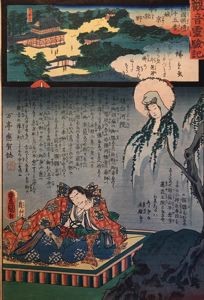
Utagawa Kunisada I (a.k.a. Toyokuni III)
Miracles of Kannon: Imakumano in Yamashiro No. 15
Japan, 1859
Full-color woodblock print; ink and colors on paper
14 ¼ x 9 ¾ in.
Purchase by the Aoki Endowment for Japanese Arts and Cultures
Scripps College, Claremont, California
2019.1.84
Kannon—the Japanese name for Avalokiteśvara—is worshipped in Japan as both a male and female bodhisattva. Here, Kannon appears to display feminine characteristics, a portrayal that conforms to the feminized aspects of Kannon that became popular during Japan’s medieval period (around 1185-1600). Four such popular Japanese female aspects are the Pure Kannon (Sho Kannon), the White-robed Kannon (Byakue Kannon), the Willow Branch Kannon (Yōryū Kannon), and the Fish Basket Kannon (Gyoran Kannon).
This print illustrates a Japanese Buddhist legend that exemplifies the awesome healing powers of Kannon. One day, the Emperor Goshirakawa (1127-1192)—the man kneeling in the foreground—began to suffer from an intolerable migraine. Seeking relief, he traveled to a Japanese Buddhist temple in Kyoto, Imakumano Kannon-ji—depicted in the background of the print—to pray for a remedy. That night, the Emperor dreamed of the bodhisattva Kannon shining a light on his head, an action that completely alleviated his pain. Due to this story, Imakumano Kannon-ji in Kyoto is renowned today as a temple associated with the curing of headaches.

Seated Tara
China, Sino-Tibetan, 18th century
Cast bronze
20 in. 13 ½ in. x 9 ½ in.
Scripps College, Claremont, California
2002.0.11
The goddess Tārā is worshipped predominantly in Tibet and its surrounding regions within the context of Vajrayāna Buddhism, an esoteric mode of Mahāyāna Buddhism that promotes an elaborate system of ritual, visualization, and meditation practices that accelerate the journey to nirvāṇa. Vajrayāna Buddhists visualize the universe as a composition of masculine and feminine energies, both of which must be understood in order to attain enlightenment.
According to Tibetan popular belief, Tārā was born from tears shed by Avalokiteśvara, who wept after witnessing the tremendous suffering of all living beings trapped in saṃsāra. She is thus considered to be a female emanation of his compassion, and sometimes his female counterpart. Tibetan Buddhists revere her as the archetype of compassion, protection, and virtuous action, and some regard her as the “Mother of All Buddhas.”
The name Tārā translates to “star” in Sanskrit, and is derived from the Sanskrit root “tṛ,” to cross over, a fitting name for this supremely compassionate entity who guides aspiring practitioners on the path to awakening, a journey that is often allegorized in Buddhist scripture and iconography as the crossing of a river or sea to a distant shore. According to Tibetan Buddhist legend, she has vowed to subject herself to continual rebirth in saṃsāra—always in a female form—to protect and assist those who call upon her in their practice.
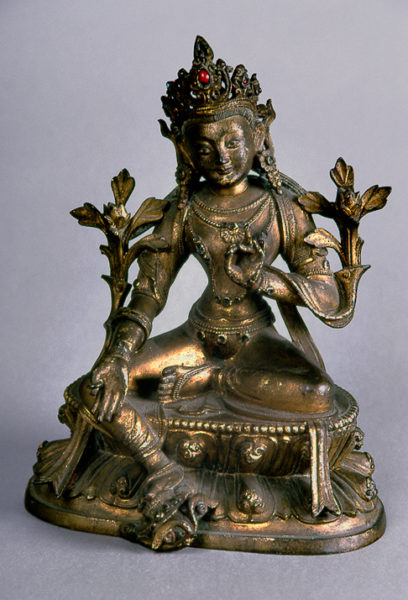
Seated Tara
China, Sino-Tibetan, 18th or 19th century
Cast bronze
6 7/8 in. x 5 3/8 in. x 5 7/16 in.
Scripps College, Claremont, California
73.4.1
Tārā is typically portrayed as a beautiful young woman with a serene expression, seated in a gentle swaying posture known as the lalitāsana, or “pose of royal ease.” Her right hand, resting facing skywards over her right knee, forms the varadamudrā, the gesture of gift-giving or charity. She joins her left thumb and forefinger in the vitarka mudrā of discussion and teaching.
Her lotus throne and the positioning of her right foot, outstretched and resting upon another smaller lotus, are indicators of her status as an enlightened being. In Buddhism, the lotus symbolizes enlightenment and purity because it germinates submerged in deep murky water—an allusion to saṃsāra—but rises out of the muck to finally bloom on the surface—an allusion to nirvāṇa. By stepping off her elevated lotus throne onto the smaller lotus which emerges from the mud of saṃsāra, Tārā reveals that she has transcended this world, yet voluntarily remains a part of it. This dynamic posture also implies her readiness to abandon her seat to aid any living being who calls upon her for assistance.
Vajrayāna Buddhists revere at least five different manifestations of Tārā: Green Tārā, White Tārā, Red Tārā, Blue Tārā, and Yellow Tārā. Each form is associated with a different element, consort, and auspicious quality. All three representations of Tārā in this exhibition are of Green Tārā, her most popular and dynamic emanation. Green Tārā is associated with virtuous activity, protection from imminent danger, and the overcoming of obstacles on the path to enlightenment. She is also associated with fertility and horticulture.
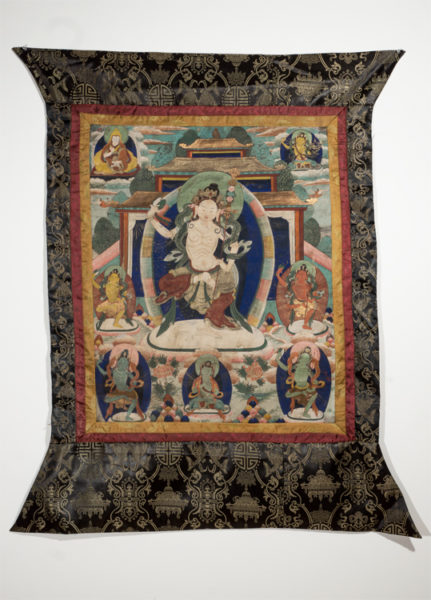
Ḍākinīs
Tibet, 19th-20th century.
Painting on Cotton
Gift of Toshie and Frank Mosher
Scripps College, Claremont, California
2007.11.2
In the Vajrayāna Buddhist traditions of Tibet and its surrounding regions, female deities known as ḍākinīs (Tibetan: khandro) are revered as symbols of wisdom and protectors of the Buddha’s teachings. Ḍākinī means she who moves, dances, or frolics in the emptiness of space—as such, they embody the Buddhist understanding that enlightenment is attained by relinquishing all attachments to the worldly affairs of saṃsāra. Depicted as lithe dancers, unfettered by clothing, they can be both peaceful or wrathful entities and convey various meanings depending on the context in which they appear. Their elusive nature conveys another fundamental Buddhist understanding of the universe as ‘empty,’ or, as lacking an underlying core or essence that is impervious to change.
This painting was most likely utilized in deity yoga visualization, a practice which requires practitioners to mentally manifest and inhabit the body, mind, and abode (maṇḍala) of an enlightened Buddhist deity. Paintings like this one are visual aids that facilitate this process. The iconic focus—the central white ḍākinī, surrounded by four smaller ḍākinīs—is the yi dam, or meditational or tutelary deity, which practitioners seek to visualize themselves as and thereby identify with. By mentally transforming themselves into the enlightened yi dam, practitioners come closer to realizing their own enlightenment.
The yi dam featured in this painting could be the 11th century Tibetan Buddhist master Machig Labdrön, believed to be the reincarnation of the great ḍākinī Yeshi Tsogyal. During her lifetime, Labdrön broke her vows as a nun to become a wife and mother—a decision which challenged the patriarchal status quo of 11th century Vajrayāna Buddhism. She is celebrated in Tibet today as the founder of the Buddhist practice of the Chöd, which remains a central component of the Nyingma tradition of Vajrayāna Buddhism.
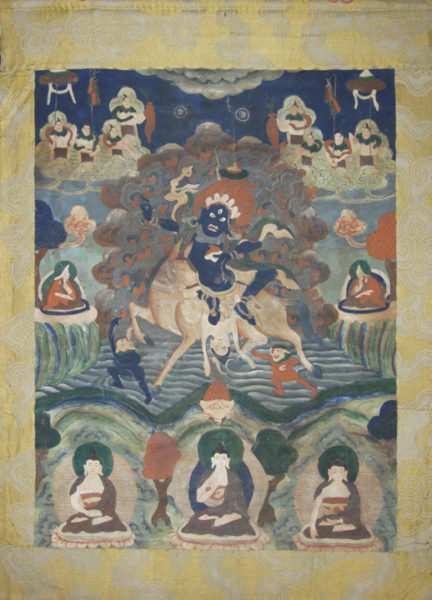
Palden Lhamo
Tibet, 19th or 20th century
Tempera on Cotton
30 in. x 19 7/8 in.
Scripps College, Claremont, California
2005.0.8
This Tibetan painting features the goddess Shri Devi (Tibetan: Palden Lhamo), one of the eight dharmapālas, or “wrathful” protector deities of Tibetan Buddhism. Palden Lhamo is the only female dharmapāla, as well as the principal female protector of the Dalai Lama and the nation of Tibet.
According to a popular Tibetan legend, Palden Lhamo was once queen of the cannibal demons of Sri Lanka. After failing to convert her subjects to the non-violent ways of Buddhism, she vowed to sacrifice her cannibal demon son. She flayed him, ate his flesh, and fled Sri Lanka on a white mule using his skin as a saddle. Albeit gruesome, this story exemplifies Palden Lhamo’s complementary roles as a strict mother and vicious protectress.
Accompanied by her two ḍākinī assistants situated below her—Makaravaktra, the sea monstress, and Simhavaktra, the lioness—Palden Lhamo rides a white mule through a coursing ocean of blood, which symbolizes the never-ending cycle of birth and death (saṃsāra) which ensnares all living beings. In her right hand, she wields a vajra scepter that holds the power to pierce the veil of illusion which keeps living beings bound to saṃsāra. In the other, she clutches a skullcap filled with bloody brains deluded by ignorance and misunderstanding. The third eye of wisdom on her forehead is wide open.
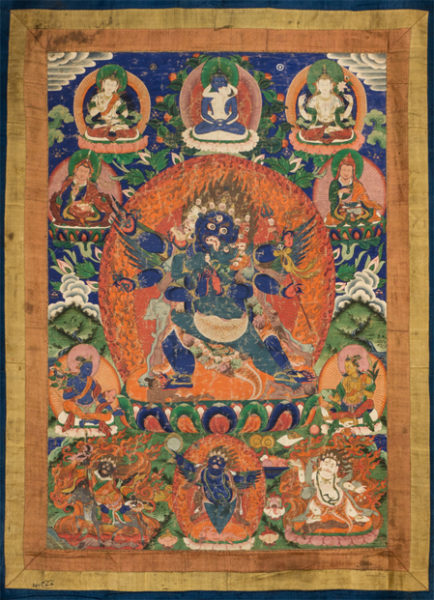
Vajrakila and Triptachakra in Yab-Yum
Tibet, 1750-1800
Tempera on Cotton
50 in. x 39 ¾ in.
Gift of Ms. Dorothy Cooke
Scripps College, Claremont, California
80.4.1
Featured at the center of this painting are two Vajrayāna Buddhist deities—Vajrakila and Triptachakra—joined in a passionate sexual embrace known as yab-yum. In the Tibetan language, yab-yum translates directly to “father-mother.” In the Vajrayāna Buddhism of Tibet and its surrounding regions, yab represents the masculine energy of karuṇā and upaya—meaning compassion and “skillful means,” or the various methods by which the Buddha’s teachings are taught to unenlightened beings, respectively—whereas yum represents the feminine energy of prajña, meaning wisdom or insight.
The union of the masculine yab and feminine yum energies, in a very general sense, exemplifies the supremely compassionate and wise state of being necessary for attaining enlightenment. On a deeper level, the merging of masculinity and femininity that takes place in the yab-yum alludes to the Buddhist understanding of all phenomena as ‘nondual,’ or, as constantly subject to change, and therefore lacking a true ‘identity.’
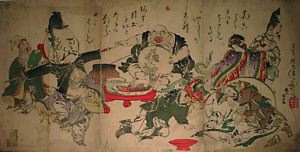
Tsukioka Yoshitoshi
The Seven Gods of Good Fortune Having a Drinking Party
Japan, 1880
Full color woodblock print, ink and colors on paper
14 13/16 in. x 29 1/2 in.
Gift of Mr. Fred Marer
Scripps College, Claremont, California
93.3.93
The Japanese goddess Benzaiten, clad in a colorful kimono on the right-hand side of this print, is a highly syncretic deity of Hindu origin who gradually assimilated aspects from Buddhist and Shinto traditions as her worship spread across Asia. She is predominantly associated with water, and by extension, with everything else that ‘flows’ like water, such as snakes, dragons, speech, and music. In her portrayals, she is often depicted playing a lute—a nod to her beginnings as the Hindu goddess of music and education, Sarasvati, who was introduced to Japan around the 7th century CE as a Buddhist deity. In the years that followed, Sarasvati metamorphosized into the goddess Benzaiten after melding with native Shinto agricultural deities.
Benzaiten is venerated today in Japan at Buddhist temples and Shinto shrines by those who seek wealth, fertility, and bountiful harvests. Although she is worshipped as an individual goddess, it is more common to see her depicted as one of the Seven Lucky Gods (Japanese: shichifukujin), as she is here. She is the only female deity in this group.
This particular print is a humorous portrayal of the Seven Lucky Gods, who appear to be jesting with one another whilst drinking themselves into a stupor. To the right, Benzaiten coyly tucks her chin into the sleeve of her kimono as she is led away by Daikoku, the god of wealth. At the center, Hotei, the god of good fortune, sits before a fish feast with his enormous belly on display, laughing at the antics of a scarecrow-like puppet. The leftmost figure—Jurōjin, the god of longevity—gapes open his mouth in what seems to be a yawn.

